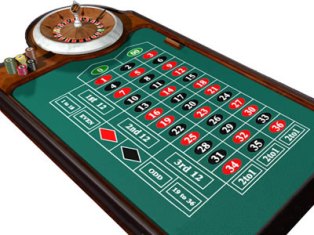
The Unofficial Guide to Casino Gambling
American Roulette - The Wheel and the Table
 Basil Nestor is the author of the new Playboy Complete Guide to Casino Gambling. This wonderful book teaches players how to avoid sucker bets and win more when playing gambling games. He is also the author of The Smarter Bet Guide series for video poker, slots, craps, and many other books about gambling. Basil's website is www.smarterbet.com
Basil Nestor is the author of the new Playboy Complete Guide to Casino Gambling. This wonderful book teaches players how to avoid sucker bets and win more when playing gambling games. He is also the author of The Smarter Bet Guide series for video poker, slots, craps, and many other books about gambling. Basil's website is www.smarterbet.com 
The layout of an American Roulette wheel. perimeter; centrifugal force keeps the ball on a grooved track as it moves. When the ball loses speed it falls into one of the numbered slots, and the various attributes of the number determine winners and losers.
The wheel’s numbers are arranged in what seems to be a haphazard fashion, but it’s actually a complex system designed for maximum variability. Red and black alternate; pairs of odd and even alternate; pairs of high and low alternate. Every odd number has its even successor directly across the wheel.
The roulette table is equally marvelous. The numbers are arranged sequentially, but the patterns of red, black, high, low, odd, and even create betting options that ensure no bet has an advantage over any other bet. The table can accommodate dozens of unique wagers; all of them have various probabilities of success and yet all of them (with one exception) have an exactly identical house edge of 5.26 percent.
The result is a game that is relentlessly systematic yet utterly unpredictable.
Roulette uses a unique system of colored chips that distinguish one bettor from another. This allows two or more people to make identical bets without confusion, and it creates some interesting contrasts. Your chips may be worth five dollars each. The player next to you may be betting one hundred dollars per chip. There is no way to know unless you watch a person buy in.
Most roulette tables can accommodate six to eight players. Just walk up and lay your chips or cash on the felt, and the dealer will give you roulette chips. As with every table game, it’s a good idea to read the upright plastic card next to the dealer. It will have important information about the game and table limits. Roulette often has different restrictions on amounts that can be wagered “inside” and “outside” the layout

This is a standard roulette table. Wagers placed directly on single numbers or combinations that pay 5:1 or better are “inside” bets. Wagers on the edges of the layout that pay 1:1 and 2:1 are “outside” bets.
Online American Roulette
Playing American roulette online brings the thrill of the classic casino game right to your fingertips. Using a system called a Random Number Generator (RNG), it makes sure every spin is as random and fair as if you were watching the ball roll in a real casino. Keeping true to the original game's setup, the wheel has 38 spots, including numbers 1 through 36, a zero, and a double zero. However, online roulette platforms may offer additional features like statistics, betting patterns, and special bonuses."Inside bets have the highest payoffs and the highest probability of losing.
A straight bet is a wager on one number. Just put your chips on the number. The casino pays 35:1 if the ball falls on that number.
A split bet is a wager on two numbers. You make the wager by putting your bet on the line between two numbers. The bet wins if the ball falls on either number. The casino pays 17:1 on a split bet.
A street bet is made by putting one or more chips at the end of a row of three numbers or at the intersection of three numbers at the top of the layout. The bet pays 11:1.
A square or corner bet is made at the intersection of four numbers. The bet pays 8:1.
Six-number bets are placed on the intersecting lines at the end of two rows. They pay 5:1.
American roulette has a five-number bet. It’s made at the end of the row where the one and the zero intersect and it covers zero, double-zero, one, two, and three. It pays 6:1 and it is the only exception to the 5.26 percent rule. A five-number bet has a house edge of 7.89 percent.
Bets on the outside of the layout cover more numbers and they win more often, but they pay less. The payoff is 2:1 when you win on a group of twelve (1 through 12, 13 through 24, or 25 through 36). You can also bet a column of twelve numbers for the same payoff.
The remaining outside bets are red, black, even, odd, 1 through 18, and 19 through 36. They all pay 1:1.
The preceding material is a portion of what you'll find in Basil Nestor's Unofficial Guide to Casino Gambling.
